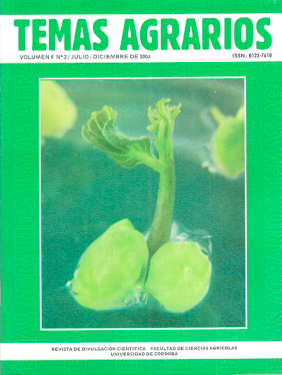Mepiquat chloride effects on yield and photosynthesis cotton (Gossypium hirsutum L.) var gossica MC23
Efectos del cloruro de mepiquat en la fotosíntesis y parámetros del rendimiento en algodón (Gossypium hirsutum L.) var Gossica MC23

This work is licensed under a Creative Commons Attribution-NonCommercial 4.0 International License.
Show authors biography
The present work was carried during second semester of 1999 at the Turipaná Research Center of Corpoica Regional 2, deparment of Córdoba, altitude of 14 m.a.s.l, temperature of 28°C, RH of 85% and annual rainfall of 1,200 mm. The main objective was to determine the effect of mepiquat chloride (MC) application on cotton yield and photosynthesis. A complete block randomized design was used with 4 replicates, where treatments consisted of four dose of MC (0, 25, 50 and 75 g of a.i. ha -1) on cotton plants Var. Gossica MC-23 at beginning of flowering. Every week total chlorophyll concentration and photosynthesis rate were evaluated. The other variables were: weigh pcr speck, fiber percentage, fiber index and yield of cotton seed, and fiber yield. The results showed that 25, 50 and 75 g of a.i. ha -1 of CM decreased the fiber index and the seed number pcr speck, while the weight of the speck was not affected. The variable yield of cotton seed, fiber percentage and fiber yield decreascol when the dose of CM was increased. Since day 34th after spraying the CM (94 days after planting) and with increasing the dose, the chlorophyll concentration also increased; however these did not have any influence on the photosynthesis rate.
Article visits 1607 | PDF visits
Downloads
- BASF. 1980. PIX. Bioregulador para el cultivo del algodón. Bogotá, p.15 BASF. 1990. Bioreguladores en el cultivo del algodonero: En Infobasf. 2, Bogotá, p.16
- Biles, S. y Cothren, J. 2001. Flowering and yield response of cotton to application of mepiquat chloride and PGR-IV. Crop Science 41:1834-1837
- Duli, Z.; Derrick, M. y Oosterhuis, 2000. Pix Plus and Mepiquat Chloride Effects on Physiology, Growth, and Yield of Field-Grown Cotton. Journal of Plant Growth Regulation. 19(4): 115-118
- Espitia, M. y Zapata, J. 1992. Evaluación de diferentes poblaciones del algodonero en la variedad Gossica MC 23 bajo aplicación de pix. Tesis Ingeniero Agrónomo. Universidad de Córdoba,
- Montería. Guthrie, D.; Landivar, J.; Munier, D.; Stichler, C. y Weir, B. 1995. Pix application strategies. Cotton Physiology Today. 6(4): 4 Hake, K.; Kerby, T.; McCarty, W.; O’neal, D. y Supak, J. 1991.
- Physiology of pix. Cotton Physiology Today. 2(6): 4 Landivar, J. y Marur C. 1996. Photosynthesis and translocation of sugar in cotton plants to drought stress after mepiquat chloride applications. In: Beltwide Cotton Conference, Nashville, TN, p.1234
- Saénz P. 2004. Los Reguladores de Crecimiento en la producción de algodón. Una herramienta más para el manejo del cultivo. http:// saenzpe.inta.gov.ar/Ecofisiologia/ Ecofisiologia.html [Accedido 14-11- 2004]
- Salisbury, F. y Ross, C. 1992. Fisiología Vegetal. Iberoamérica, S.A. de C.V. México D.F., p.759
- Schott, P. y Heydendorff, R. 1981. Pix: Un biorregulador para el algodón. En: BASF reporte agrícola. Edición especial.
- Wearver, R. 1982. Reguladores del crecimiento de las plantas en la agricultura. Trillas, México, p.438




















